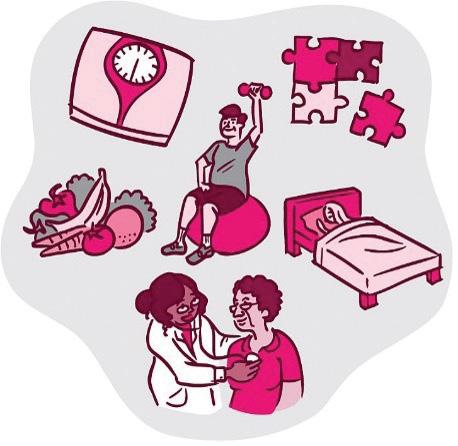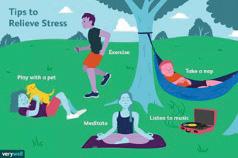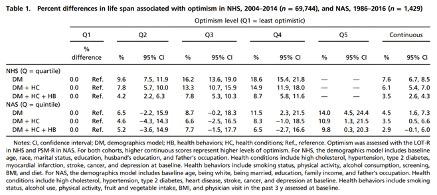
6 minute read
The Secrets to Long Life A Cardiologist’s Perspective
The Secrets to Long Life
A Cardiologist’s Perspective
BY MIAN A. JAN, M.D., F.A.C.C., F.S.C.A.I., AND SURAJ JOSHI
“It is our duty, my young friends, to resist old age; to compensate for its defects by a watchful care; to fight against it as we would fight against disease; to adopt a regimen of health; to practise moderate exercise; and to take just enough of food and drink to restore our strength and not to overburden it… greater care is due to the mind and soul; for they, too, like lamps, grow dim with time, unless we keep them supplied with oil.” (de Senectute §11)
You may have heard the above from a doctor (without the flowery language). But it’s actually from Cato Maior de Senectute, an essay on aging written in 44 BC by the Roman rhetorician Cicero. Cato the Elder, 83 years old, advises two 30-year-olds who heard terrible things about old age. They demanded that Cato explain how he survived so long. Arguably, Cato’s response is the best prescription for longevity even now.
Of course, medical wisdom has progressed since Cicero, especially in the last century. In 1900, people in the US lived on average to 47 years (CDC). Now, it’s up to 81 years – almost double. If we double it again in the next century, we’ll live to over 150.
Yet in many ways, the best advice has stayed the same. With few modifications, the Harvard Health blog agrees with Cato above, recommending that people avoid smoking, challenge their minds, exercise every day, and eat healthily. The Princeton Longevity Center also recommends regular preventative medical exams like colonoscopies, cardiovascular stress tests, and immunizations.
Staying on top of all this can be daunting, but it’s never too late to commit to a longer, healthier life. In §2 and §3, we’ll review the best medical recommendations for prolonging life. We’ll cover some new research on prolonging life in §4. We’ll conclude with the key takeaways in §5.
§2. What to do.

(Image: NIH News in Health)
Eat healthily; eat less. Eating a balanced diet full of fruits, vegetables, and diverse protein sources adds up to 13 years to your life (Fadnes 2022). But it can be difficult to keep all the diet recommendations straight. The Harvard Crimson has an excellent rubric for portioning foods throughout the day.
As a general rule, green plants and vegetables are good (spinach, kale, green peppers). Margarine-based foods and white bread/pasta are bad due to their highly processed nature and high carbohydrate content.

The Secrets to Long Life
continued from page 11
Exercise. Most professionals recommend 150 minutes of moderate exercise per week. And we don’t have to spend all this time at a gym or fitness center. David Fein at the Princeton Longevity center remarks that the US has more gyms than any other country, yet obesity rates have doubled since 1980, making the US one of the most obese countries in the world.
People around the world walk to work, walk to lunch, walk during work, and walk afterwards to social activities and home. They spread out their exercise; we can too. We can take 5-minute breaks for brisk walks, or squeeze in ten push-ups while watching TV during commercial breaks. Intermittent moderate-intensity exercise can get us up to 150 minutes easily.
Avoid stress. Heavy, chronic stress can lower life expectancy by 3 years or more (Härkänen 2020). It’s important to practice healthy ways of reducing and coping with stress. Eating right and exercising help in this department, but any relaxation strategy works.

(Image: VeryWell / Joshua Seong)
A striking 2019 study (Lee 2019), summarized in Table 1, corroborates these recommendations. The study found that optimism about life contributes up to 12 years (11-15% extension) towards life expectancy. The results were found to be independent of socioeconomic status, health conditions/behaviors, and mental health conditions.
Finally, Stay on top of your tests. Start getting colonoscopies at least once every decade from age 45. Take a cardiovascular stress test and EKG if you have abnormal heartbeats or experience abnormal breathing. Get vaccinated for the flu, COVID-19, Tdap, and shingles.
§3. What not to do.
Don’t smoke. Smoking kills. Figure 1 shows up to a 7.5-year decrease in life expectancy from smoking, but recent data from the CDC indicates a 10-year difference between smokers and nonsmokers. Smokers increase one’s risk of dying by lung cancer and bronchitis by more than 12 times.
Good news: in 2018, more than half of adult smokers tried to quit in the past year (CDC). 7% succeeded, indicating quitting was difficult. But it’s still worth striving to break the habit.
Don’t drink heavily. Heavy drinking is defined as consuming more than 14 drinks per week for men, or more than 7 drinks per week for women. Heavy drinking can take up to 5 years off your life, and is the third leading cause of preventable death in the US (NIAAA 2022).


§4. What’s the limit?
Jeanne Louise Calment lived to 122 years, achieving the longest lifespan of any human in history. She died in 1997. It’s natural to ask if we can beat that record, and by how much. Recent studies have suggested the limit is 150 years (Pyrkov 2021). After that, theoretically, the body can no longer repair age-related tissue damage.
Jeanne Louise Calment (Image: Reuters)
But recent research on stem cell therapy suggests we could extend life even further. Stem cells are the building blocks of our body. They can develop into almost any type of specialized cell, be it blood, liver, bone, or skin cells. They can renew and replicate themselves. They also play a critical role in repairing damage to our organs by “filling” in for dying tissue after differentiating into the requisite cell type.
Unfortunately, as we age, so do our stem cells: their powers of self-renewal and differentiation diminish. Up until recently, efforts to hijack and reverse this process have progressed slowly. But now, major clinics like the Penn Institute for Regenerative Medicine have begun exploring methods to transplant young stem cells into aging patients, allowing them to rebuild healthy tissue.
Stem cell therapies tend to follow this outline: 1. extract stem cells from a compatible donor; 2. enrich the extract for young stem cells; 3. intravenously transplant the young stem cells into the patient’s bone marrow.
We don’t know how long this can extend life, but such procedures have been shown to attenuate multiple age-related symptoms such as fatigue, pain, and immobility (DVC Stem 2021).
It doesn’t stop there. We stand on the precipice of growing entire new organs using stem cells via “bioprinting” them into an organ scaffold in a 3D printer (Al Idrus 2020). Previous efforts to do so failed due to an insufficient understanding of organ architecture, but we understand it much better now. Grow a million stem cells, induce them to differentiate into your cell types of choice, put them into an organ scaffold, and you’ll have a new organ.
Artificial organ transplanation involves significant risks of rejection reactions. But if we succeed at it, we will have to completely rethink the limits of aging.

(Image: adapted from The Scientist staff 2020)
§5. Key Takeaways.
Key Takeaways for a long life
You don’t need stem cell therapy or advanced technology to live long. For the most part, Cicero has already covered the basics. I give my patients this brief advice: “Eat less, do more, try not to worry, avoid bad habits, and you can live a long, healthy life.”










